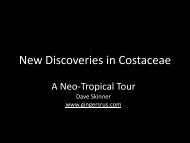You also want an ePaper? Increase the reach of your titles
YUMPU automatically turns print PDFs into web optimized ePapers that Google loves.
PAGE 6 THE <strong>BULLETIN</strong> / JANUARY 2010cies pretty much with just sheer luck.Our next locality was the mythical Lita region closeto the Colombian border in Carchi Province. I have fondmemories of being a very young heliconia enthusiast withFred Berry telling me tales of collecting in this region byhim and others back in the 80s. To get there from San Miguelde los Bancos meant another huge drive through theback blocks, although there was the tantalising sound of anew road up to Otavalo. We travelled over some veryrough roads down steep canyons with no other traffic onthe roads. Somewhere along through this area we cameacross another pendent species that we have no idea as toits identity—red with some black hairs, as well as some onthe foliage midribs as well as clasping leaf bases, anotherFRPH. Images were captured for referral to more informedindividuals. Being an enthusiast means you areonly as good as the botanical descriptions or books you arecarrying with you on the day and Carla had pretty mucheverything she could lay her hands on. I had downloadedimages on my laptop from the Smithsonian Type SpecimenRegister prior to trip to help.The new road to Otavalo turned out to be quite aconstruction which was in progress. Bulldozers carryingbeautiful pink sausages of explosives tied up with canaryyellow detonation cord, made way to more bulldozersclearing rock falls that could be used as roads. Needless tosay our little 4WD with minimal ground clearance justmade it through without needing a push from the dozers orall of the passengers to get out as we had to in other sectionsand some creek crossings.The next day we arrived in the Lita-Alto Tamboregion along a newly laid hot mix asphalt road that lookedas if formula-1 race cars could use it as a testing track, sosmooth the surface was. This had me thinking how hardthe travel was in the old days when there was just thetrain and hard roads to get into this river valley thatstarts as an arid wasteland and as it drops down into theEsmeraldas Province where the Chocó region is justacross the border in Colombia, reputed to be one of thewettest regions in the world. Rapid clearing is occurringin the surrounding areas as elsewhere in Ecuador as thegrowing population look to have their own farms forfood production and somewhere to bring up their growingfamilies. We travelled as many roads as we couldand found the following species of <strong>Heliconia</strong>: H. nigripraefixa,an all red form of H. harlingii, H. latispatha,H. regalis, more pink with yellowish hairs, H. obscuroides,and another red pendent with necrotic tips thatmay be H. fragilis.The plant we were hoping to see was H. lutheri - ahairy pendent from the Barbatae group with white waxyundersides to its leaves. We spent two days lookinghigh and low but came up empty. We saw lots of whitebacked Calathea lutea but not the elusive H. lutheri.This trip was a fantastic adventure and we certainlysaw lots of Ecuador and its natural beauty in twoweeks. Without Carla Black and Angel Rodriguez thereis no way someone like myself who can really only ordera cerveza and ask for the bill in Spanish would be able toget around with the absolute freedom we enjoyed and Iam eternally grateful for their generous company.Above, left to right:H. obscuroides;H. cf. fragilis (betweenLita and Alto Tambo)Below and right: wildlifeAbove left: preparing aspecimen of H. aemygdiana(photo: Dave Skinner)Above right: waterfallnear H. brenneri locality,Gualaquiza-Sigsig road.Below right: roadblocked by landslide


